Excellent sales copy is like art. It may seem simple, but you can rest assured that there are hours of work, tons of skill, and years of experience behind every single sentence on a high-performing site.
Sure, copywriting isn’t a job suited to everyone out there (not even all writers do well with producing copy that sells). Nonetheless, there are several ways marketers can use language to boost sales. The following eCommerce copywriting tips will help you do just that. They’ll teach you how to use a combination of behavioral psychology and real-life experience to make data-driven decisions that are sure to pay off.
Let’s dive right in.
1. Generate Emotions
While we humans like to think that we’re rational creatures, science suggests otherwise, especially when shopping.
Research from the past three decades shows that people don’t always make purchasing decisions based on data. More often than not, they decide what to buy depending on their emotional response to brands’ propositions.
Let’s look at a few recent research projects.
One study from 2016 examined consumer behavior connected to purchasing decisions. It found that consumers made their buying choices depending on the emotions they expected to experience as a result of the purchase. A different research paper looked at shopping behavior among people with low-self esteem. It discovered that, for these people, it was an emotional response that made them compulsively buy online. Finally, one study discovered that negative emotions, like sadness, encouraged consumers to purchase by inspiring them to change their circumstances.
Considering this knowledge, brands should consider ways to enrich their eCommerce copy with emotional appeals. But what’s the best way to boost sales?
Well, the answer to this may lay in Unbounce’s 2021 Conversion Benchmark Report.
In this study, researchers detected that negative language sentiments like sadness and fear caused conversions to drop. But, positive keywords caused an increase in landing page performance.
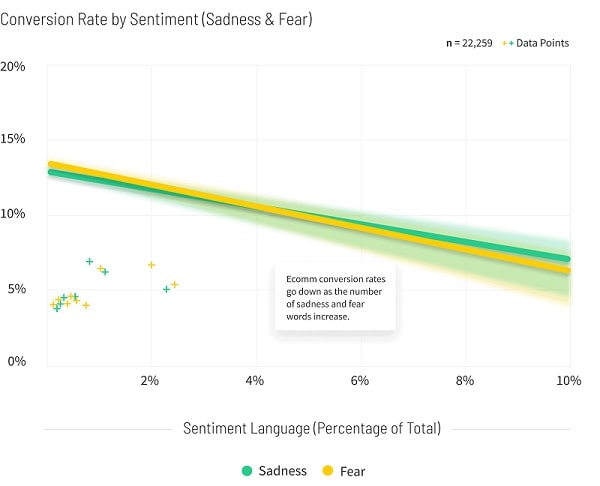
So, if you’re looking for ways to improve your eCommerce copy, don’t hesitate to use positive emotional language.
The brand Impossible does this superbly with its homepage copy. It uses the sentence “It’s like you – but with superpowers.” And with it, it inspires web visitors to tap into their motivation and ambition for bettering themselves. The copy encourages potential buyers to chase their dreams of high energy, better sleep, and more productivity.
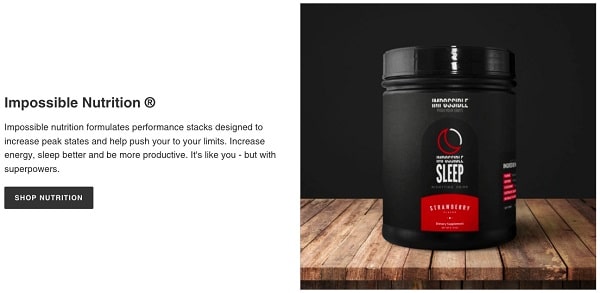
2. Speak With Authority
OK, so you know that emotional language sells. But is it enough to convince all consumers? Not quite.
Over the past few years, scientists have been studying the elements that influence consumers’ perceptions of brands. They found that two factors impact how people see organizations:
- Warmth, which appeals to consumers’ emotions and shows that the brand has worthy intentions; and
- Competence, which speaks about the brand’s ability to fulfill its promises.
Based on this hypothesis, scientists studied which of the two was more impactful in driving purchases: warmth or competence.
They discovered that brand warmth positively influenced emotional and functional value associated with the brand. However, competence also boosted buying intentions.
With this in mind, emphasizing brand authority can be as effective at boosting sales as using emotional language.
There are several ways you can do this with eCommerce copywriting.
For example, you can use language that draws web visitors’ attention to the social proof on your landing pages. Or, you can highlight the quality of your products by describing the materials used for their production, as Made In Cookware did.

However, if you want to have the highest chance of boosting brand authority (and conversions) with website copy, the best thing you can do is address the value your audience receives by investing in your products.
Rain or Shine Golf does this incredibly well. The brand speaks about its range of products “meticulously developed” to “elevate [consumers’] golf simulator experience” and designed “based on feedback from hundreds of […] customers.”

3. Tell a Story and Make the Reader Its Hero
Brand storytelling is a great method of using narratives to build relationships with your audience.
And that’s not just because the brain’s natural response to stories is to release oxytocin (and make us more likely to have an emotional reaction). Much more impactfully, these tales allow brands to create narratives with their consumers at the center of them.
So, when looking to boost sales with eCommerce copywriting, consider whether there’s a way for you to hook your audience with a story that reflects their situation. Turn your readers into heroes and address the problems they’re trying to solve. Then, present your products as the solution.
Jacked Factory does this beautifully on its homepage’s “Finish Unfinished” section. It uses storytelling to describe its ideal buyer: a fitness enthusiast pushing towards their goals.
The copy speaks directly to the reader. It addresses them as “you.” It sketches a detailed scenario, telling a story of how dedicated “you” are when it comes to chasing your fitness objectives.
This provides the perfect segue into the copy’s main sales pitch, where the company’s products are positioned as essential to the journey they just discussed.
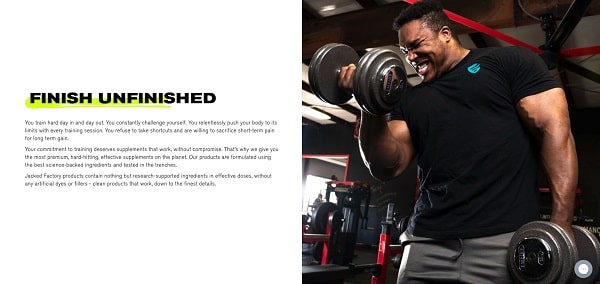
4. Sell Value, Not Features
Brand storytelling is one way to employ a user-centric approach to copywriting. But it’s definitely not the only one that works.
Focusing your sales copy on the benefits of your products instead of their features is another example of how you can use language to boost sales.
Marketing experts agree that user benefits trump features. This is because they focus on what a product can do for the customer.
Think about it. Most buyers won’t even bother to check how many mAh their next smartphone battery will have. All they want is the assurance that the device can make it through the day on a single charge.
So, when copywriting for your eCommerce site, try to sell value instead of features.
For a great example of how you can do this, check out the Kaia Naturals homepage. See how the copy emphasizes the gentleness of the products? But, also notice that the copy is not only about benefits. It still addresses the ingredients. However, it only mentions them to achieve the desired goal, leaving potential buyers thinking about the product’s benefits – not its ingredients.

5. Keep It Simple
One easy trap to fall into when writing copy for eCommerce pages is to get carried away. The Unbounce report (quoted at the beginning of this article) found that both word count and readability affected conversion rates.
According to this document, conversion rates started to decrease after the 300-word mark. But, they grew when the copy scored higher on the Flesch reading scale. This indicates that short, easy-to-understand text makes for the best eCommerce copy. At least when aiming to boost sales.
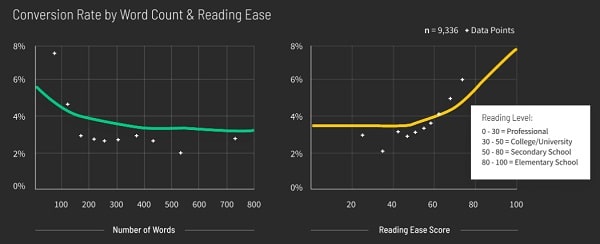
For an example of a brand that does well at writing short and simple copy, you can check out Mixam.
On its homepage, this brand states that* “Seeing (and feeling) is believing.”* By using this phrase, it’s attention to the fact that for a print to be excellent, it must both look good and have a good texture. And Mixam promises to deliver on both points. Thus, it’s no surprise that it’s quickly taking over the printing service industry. After all, Mixam offers great quality service, without all the fuss.

6. Highlight Risks, But Do It With Subtlety
Using copywriting to draw your audience’s attention to the risks involved with their purchase will help boost sales.
Now, you may think this is crazy. After all, why would you try to sell products by calling attention to the possibility of the buyer not finding value in their purchase?
But here’s the thing. By highlighting some of the risks of purchasing a product, you can position your brand as the solution your buyers didn’t even know they needed.
Take Real Thread, for example. On its homepage, this brand does the unthinkable. It reminds web visitors that people usually don’t wear custom shirts. The unconventional title does a splendid job of grabbing user attention. It addresses common consumer pain points then offers a solution right away. The result of using such copy is positive. It instills a sense of safety. Moreover, it reassures web visitors that they’re making the right decision by opting to shop with Real Thread.
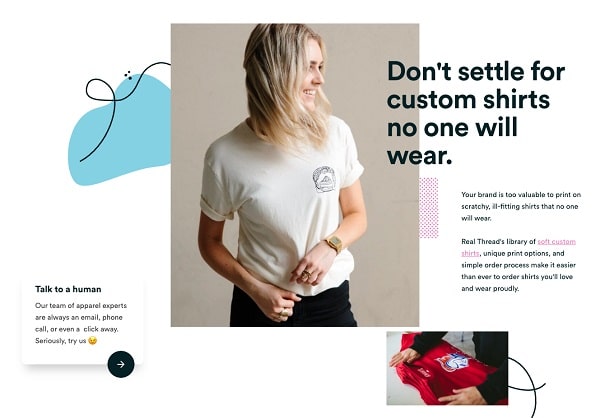
7. Maintain a Consistent Voice
The buyer’s journey isn’t a straight line that goes from point A to point B. In fact, there are several steps that buyers have to go through before becoming customers. And some resources suggest that it takes between 5 and 8 touches, on average, to generate a sale.
But what happens during these touches?
Well, these interactions allow brands to deliver messages about their solutions to consumer pain points. But, for these messages to be effective, they have to be consistent. They have to continually present consumers with new benefits while reinforcing the value that makes up the core selling point of the product.
So how does this translate to copywriting?
It reinforces the need for conversion-boosting website copy to be consistent in tone.
First, start by defining your target audience. Then, you can model your brand’s voice to appeal to that group of people. Of course, to do so, you need to ensure that you consistently use that voice throughout your website.
For example, you can identify the keywords with the most persuasive power over your audience. Or, you can settle on a way of presenting information that’s effective for your products. You can even pinpoint a tone that appeals to your target customers, using it to position your brand as a business they relate to.
To see these tips in action, check out Future Kind. On its homepage and product pages, this brand calls attention to the fact that it offers clean, sustainable, and vegan supplements made by experts. Moreover, it utilizes a highly-informative tone throughout the site. This establishes and reinforces the brand’s voice and helps consumers understand that this brand’s products are worth the investment.
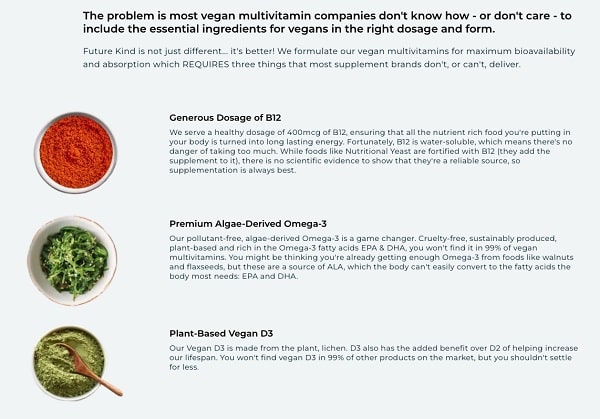
8. Differentiate Yourself
Finally, as you look for eCommerce copywriting tips that boost sales, remember that online retail is a rapidly growing industry.
According to Insider Intelligence, the sector will grow 16.1% in 2022. This means that businesses will have to work that much harder to stay ahead of the competition.
And, the best way to do that? Use website copy to point out the distinctive value offered by your products.
Think about it. What is it that differentiates your brand from your competitors? Is it the 24/7 customer service you offer through a variety of channels? Perhaps it’s the premium materials that ensure the longevity of your products. Or, it may be the skill and craftsmanship of your employees who create one-of-a-kind items consumers can’t get anywhere else.
Originality is what Mezcal For Life emphasizes on its homepage. It uses words like “handmade” and “unique finds.” And by doing so, it calls attention to the fact that these heritage products are nothing like the mass-produced alternatives offered by the brand’s competitors.

Related Content
- The Most Essential eCommerce Marketing Tactic Walkthrough
- 16 eCommerce Website Best Practices to Improve Your Sales
- 7 Best eCommerce Experts You Should Know & Their eCommerce Best Advice
- 12 Must-Have eCommerce Features to Increase Sales (+ Checklist)
- 5 eCommerce Success Stories to Inspire Your Next Marketing Campaign
- Native Ads for eCommerce: Boost Your Online Business with More Sales
Conclusion
It may not always come easily. But high-converting eCommerce copy is possible if you know the key areas to pay attention to.
The copywriting tips discussed in this article are an excellent place to start. Use the one you like the most or combine them for the highest possibility of success:
- Use emotional language to forge connections with your audience.
- Position your brand as an authority and a trustworthy source of products and information.
- Make your copy user-centric. Put your readers at the center of your brand storytelling.
- Focus on product benefits, not features.
- Keep your copy short and simple so as not to overwhelm website visitors.
- Address consumer pain points but make sure to offer solutions immediately.
- Maintain a consistent voice and tone throughout your web pages (and other distribution channels).
- Differentiate yourself from the competition. Help your audience recognize the unique value you bring to the table.
If you’re not sure whether a particular tip will help you boost sales, don’t hesitate to try it out. Employ A/B testing to see whether it yields results. That way, you can rest assured you’ve made a data-backed improvement to your site that is guaranteed to boost sales and grow your business.

Written by our guest writer Karl Kangur
Karl is a serial entrepreneur. He founded his first online business as a teenager. And loves to deliver amazing results to his clients. He is also a competitive bodybuilder, against the warnings of his doctor.



